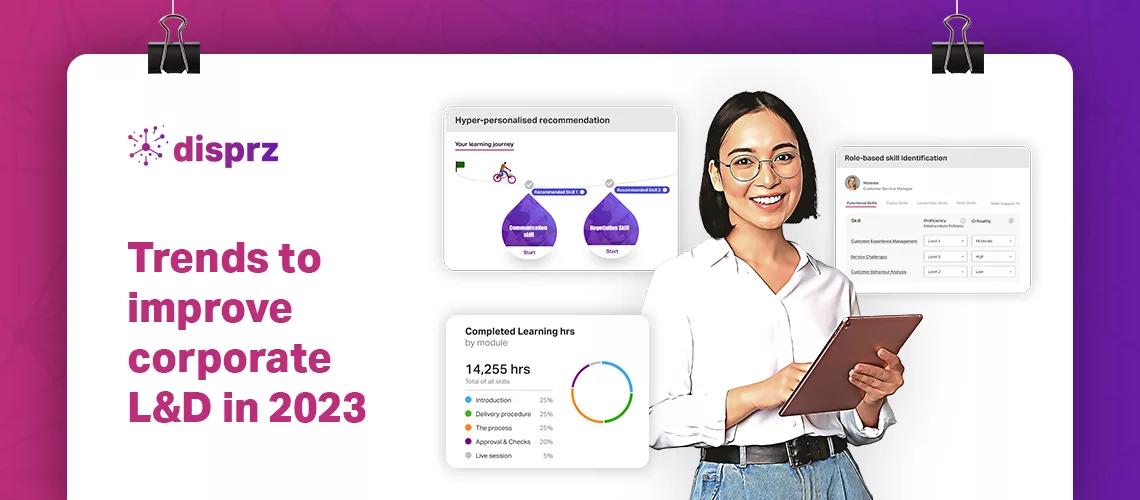
6 min read
• 24 Apr 2024
5 Learning and Development Trends for 2024
New learning and development trends arise every year. Here are the top 5 learning and development L&D trends for 2024 that you shouldn't miss!
-
eBookEmployee Upskilling - A Detailed Blueprint For Building A Skills-Driven Learning Culture
Did you know that 88% of c-suite executives believe providing employees access to learning and development is critical to their organization’s business strategy to achieve their goals? Like the pandemic decimated many paradigms, businesses are having to cope with new ways to tackle the issues clutching the world in 2024.
L&D professionals are taking a closer look at the most recent learning and development trends to design employee upskilling programs that proactively deal with the upcoming challenges they will face this year. Continue reading to discover the latest L&D trends to enhance your strategies for 2024.
Top 5 Corporate Learning and Development Trends for 2024
In the post-covid era business leaders have witnessed the success of innovative learning and development trends introduced by the L&D leaders. These trends include blended learning, microlearning, immersive learning, gamification, and more. L&D teams continue to implement these strategies successfully in their corporate training to carry on the journey of digital transformation and talent development.
With the focus on driving organizational growth, here are the leading learning and development trends companies are now targeting to incorporate into their learning culture:
1. Role-based Skill Mapping & Assessment
Role-based skills have become pertinent for success, making skill mapping critical for leaders to recognize the right training content to build those skills. With the current dynamic setting, it’s no longer just for the technical or functional skills, but role-based specializations which have taken precedence.
Organizations can achieve collective outcomes by utilizing a combination of corporate learning and development strategies and tactics on two main fronts:
-
Bolster the internal talent pool by incorporating in-demand skills
-
Synchronize the talent strategy with the overall goals of the organization
Skill mapping and assessment are two sides of the same coin. Skill mapping helps an organization identify the required skills and creates a skill inventory. The next step is to assess the employee’s proficiency level for the identified skills with the right skill assessment.
For example, in the retail sector, a sales associate should have the knowledge and skills to convert a potential prospect into a customer, but when assessed on product skills, the sales associate needs a little more proficiency in product knowledge.
The L&D team can plan a journey to enhance that skill, ensuring customer satisfaction and sales growth. Businesses can stay ahead with assessments and training by curating the right training content to bridge any identified skill gaps.
2. AI-Powered Personalized Learning
As roles within organizations become specialized, personalized learning is necessary for employees to acquire the skills needed to perform their job efficiently. Personalization allows learners to focus on the relevant skills and knowledge rather than a one-size-fits-all approach. By introducing personalization to your corporate learning and development programs, you can improve employee development, engagement, retention, and overall job performance.
In 2024, learning teams can personalize the entire skilling journey effortlessly with AI-powered employee learning platforms. AI-driven personalized learning helps L&D leaders identify and address skill gaps by analyzing performance data and identifying areas where they need improvement.
3. In-Depth Learning Analytics
As a leader, you must enhance the efficacy of your strategy by incorporating learning analytics techniques. This L&D trend enables you to gain valuable insights and make data-driven decisions, elevating the impact of your organization’s training initiatives. Prove the value of your learning investments and drive business results with hard data, not just words.
With the aid of technology, corporate L&D heads can utilize the comprehensive view of learning analytics for the right information to target your investment, as it demonstrates the ROI of each learning module. It’s a learner-centric approach that helps learning professionals identify areas where employees struggle and to make informed decisions in the future.
4. Social & Collaborative Learning Through Technology
Social & collaborative learning promotes an engaging and effective way to train employees. This L&D trend gives employees a platform to learn from their peers by encouraging knowledge sharing and collaborating on projects, resulting in increased productivity, job satisfaction, and ultimately, the success of the company.
Social and collaborative learning can occur both synchronously and asynchronously within the organization. You can leverage advanced platforms like a Learning Experience Platform (LXP) to facilitate employees’ acquisition skills via seamless access to diverse learning content. This creates a sense of community building where learners, as they not only work towards their own personal and professional development but also contribute to the growth and development of their colleagues.
5. All-In-One Learning Platform
Gone are the days of using multiple platforms for training, analytics, and more. Today, L&D teams can drive all corporate learning and development efforts on a single, all-in-one learning management system, making it easy to monitor employee progress and ensure everyone is on track to reach their goals. They can gain valuable insights and make data-driven decisions to improve training programs and drive better outcomes. The platform also eliminates employees’ need to switch between multiple applications, making the learning experience more seamless. This supports employees to learn in the flow of work without leaving their digital tools.
Among these learning and development trends, this one definitely tops the list. That’s because a single access platform enables access to training material at the moment of need, resulting in more engaging and interactive learning, reduced onboarding time, and improved productivity.
The Bottom Line
2024 is a year of change and uncertainty for businesses, and organizations will need to adapt and find new ways to train and develop their corporate workforce. The above learning and development trends allow organizations to create engaging learning experiences, and foster a continuous learning culture.
Advanced AI-driven learning platforms like Disprz LXP provide a comprehensive learning solution for corporate employee training to manage and deliver these and similar trends on a single platform, which makes it an essential tool for any organization that wants to train its workforce effectively.
By incorporating these learning and development trends into your strategy, you can ensure that your employees have the knowledge, skills, and abilities to meet the demands of their roles and the organization’s overall objectives.
Take your corporate workforce training up a notch with Disprz LXP.
About the author

Debashree Patnaik
Debashree is a seasoned content strategist at Disprz.ai, specializing in enterprise learning and skilling. With diverse experience in B2B and B2C sectors, including ed tech, she leads the creation of our Purple papers, driving thought leadership. Her focus on generative AI, skilling, and learning reflects her commitment to innovation. With over 6 years of content management expertise, Debashree holds a degree in Aeronautical Engineering and seamlessly combines technical knowledge with compelling storytelling to inspire change and drive engagement.
More Resources
4 min read
• 15 Apr 2024
Unlocking the Power of Managerial Engagement in Talent Development
4 min read
• 09 Apr 2024
Nurturing Excellence in Building Leadership Pipelines
Sign up to get free resources and stay up to date with Disprz!
Discover how Disprz can align learning and upskilling with your desired business outcomes.





